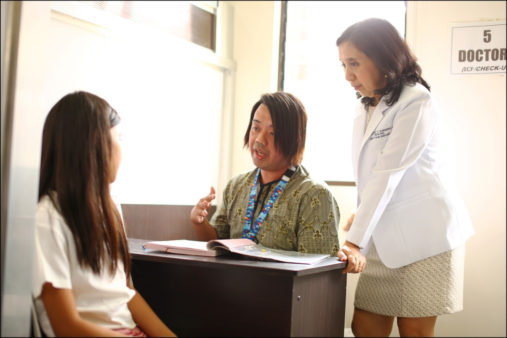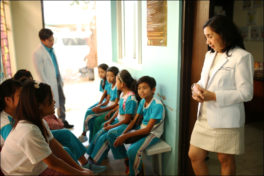- by KRIZETTE CHU
Working towards a dengue-free Philippines: a look at the country’s vaccination program
Lessons and challenges from the first country in the world to vaccinate in a public health program.
Could a dengue-free Philippines be on the horizon? The populous southeast Asian nation is moving in the right direction but the dengue burden remains high.
For many doctors and public health stakeholders, the Philippines taking the lead in providing its citizens with a free dengue vaccine couldn’t have been more appropriate. Professor Tikki Pang of Singapore’s Lee Kuan Yew School of Public Policy says it’s the country coming full circle.
“The first dengue epidemic was recorded in the Philippines in the 1950s,” he says, “and now you see the Philippines is also the first country to take its fight against dengue seriously by taking the initiative to vaccinate its children.”This tropical country in Asia sees about 200,000 infections a year, and dengue has become a year-round threat.
This tropical country in Asia sees about 200,000 infections a year, and dengue has become a year-round threat.
Asia currently bears 70 percent of the world’s dengue burden. An analysis published in the New England Journal of Medicine reports that the Philippines had the highest incidence of confirmed dengue in the 10 endemic countries that participated in the clinical efficacy studies for Dengvaxia. The analysis also reported that up to 15 percent of febrile disease in children 9 years and older in the Philippines is due to dengue.Different administrations have handled the dengue burden differently, all with the goal towards greatly reducing the mortality rate, but the dengue prevention program—first initiated in 1993 and launched in 1998—seemed less and less effective.
Different administrations have handled the dengue burden differently, all with the goal towards greatly reducing the mortality rate, but the dengue prevention program—first initiated in 1993 and launched in 1998—seemed less and less effective.The Philippines’ plan of action included spraying insecticides during outbreaks, employing chemical and biological larvicides, physical removal of breeding sites, and health education. It also started what became known nationally as the “4S Strategy”: Search and destroy, self-protection, seeking early consultation, and saying no to indiscriminate fogging.
The Philippines’ plan of action included spraying insecticides during outbreaks, employing chemical and biological larvicides, physical removal of breeding sites, and health education. It also started what became known nationally as the “4S Strategy”: Search and destroy, self-protection, seeking early consultation, and saying no to indiscriminate fogging.
The “4-‘o’-clock Habit” was a community-led activity that reminded citizens to clean their surroundings and search for possible breeding sites every 4 p.m.
But the cases continued to climb, and mortality rates spiked. The dengue control measures were largely reactive, and the mosquitoes have developed resistance to common insecticides. A dengue-free Philippines seems a long way off.Insufficient prevention and control, lack of a specific treatment, lack of prophylactic measures,
Insufficient prevention and control, lack of a specific treatment, lack of prophylactic measures, pressure to do more have pointed to one thing—the need for vaccines.
To exhausted doctors and emergency personnel, a solution couldn’t come soon enough.
And then Dengvaxia, the world’s first dengue vaccine that took nearly 20 years to develop and $2 billion dollars to produce, was launched in December 2015.
The then-President and his administration worked quickly to procure the vaccines. On Dec. 22, 2015, the Philippines granted marketing approval to Dengvaxia. Four months later, in the first week of April 2016, the first dengue vaccine program was launched in the suburb of Marikina, one of the hardest hit cities in greater Manila.
The dengue vaccine program
In an ideal world, it would have been a no-brainer for a majority of the stakeholders to show support for a vaccine that has been greatly anticipated and much needed in the country.
In the face of staggering statistics that magnify the dengue danger, Philippine health officials have decided to be pioneers in the use of the vaccine at a massive scale.
The Department of Health (DOH) worked quickly to put a structure in place and targeted 733,000 children from three regions in the first wave. The premise was simple: Start with the provinces that have reported the largest number of cases, and provide free dengue immunization to children in the fourth grade who go to public schools. In the Philippines, this means providing economically-challenged families from the pre-selected 4,827 schools the option of giving their children Dengvaxia.

Of the 733,000 targeted, 539,000 signed up. The DOH provided a ‘Quick Health Assessment Test’ and ‘Acknowledgment and Consent’ forms to the parents of these children. These set out all the conditions that were to be met before availing of the dengue vaccine.
The national school-based immunization program structure included a committee with members from various government departments including Logistics, Technical and Operations; Training and Education; Research, and Surveillance. The group worked to follow several steps: The master listing and screening of eligible pupils, the administration of dengue vaccine, the surveillance of adverse events following immunization, and recording and reporting each case diligently.
The reporting process was also flawless: The school-level nurse reported to the district school nurse, who in turn reported either to the Department of Education (DepEd) office or the local municipality, who would file reports to the central offices of DepEd and the DOH.
When the actual immunization rolled around, only 491,990 students were vaccinated.
The Challenges
Dr. Lyndon Lee Suy, a Director of Disease Prevention and Control Bureau at the DOH, says that while the government was earnest in fighting dengue, the project ran into some serious challenges: The timing of the introduction of the dengue vaccine—it was nearly vacation time when the government started the program; the looming election, which was due to happen in a month, and which meant a change in governance and health priorities and policies; and the most pressing issue of all—the lack of the World Health Organization’s SAGE recommendation, which, while not necessary in introducing the vaccine, was used by opponents to question the introduction of Dengvaxia leading to political vaccine resistance. (The WHO Strategic Advisory Group of Experts has reviewed Dengvaxia in April 2016 and recommended the introduction of the vaccine in countries or places where dengue is endemic even while awaiting WHO prequalification. The WHO has since endorsed it for use in the Philippines.)
A few stakeholders publicly questioned the safety and efficacy of the vaccine, and media coverage was largely unfavorable due to the challenges presented by these issues.
The six-months interval of dosage also increased the risk of dropouts—many children from poor families transfer schools or stop schooling, and may be unavailable to get the second dose. The issues resulted in low parental consent. 
In an interview with Break Dengue, Dr. Janette Garin, the former Secretary of the Health Department, and the person responsible for kickstarting the school-based immunization program, said, “We started the program, during my time as Secretary of Health, because we see what a big difference the vaccine would have made if everybody had access to it. It’s about making something available, easily accessible. Vaccines are mostly a prerogative of the rich, and the only time the government gave the public a vaccine program was if there was extra money. But if you do that, you don’t create real immunity among the population. If the government could afford it—and we could—why wait? The dengue vaccine could reduce the epidemic, and also help the Filipinos as it will relieve them of spending on hospitalization and buying the vaccine themselves.”
Last year, under the new Duterte government, the Congress and Senate held an inquiry into the school-based immunization program. While they moved to expand the school-based immunization program to the Central Visayas, lawmakers have also proposed waiting five years before they expand the program nationwide.
With the issue still being finalized, Dr. Lyndon Lee Suy says that the dengue vaccination program has proven that the immunization initiative has at least laid the groundwork for a future nationwide agenda: “Now we can see that we have responsive national and local partners, that we were able to disseminate high awareness in the local community,” he says. “We have also trained our teachers as reporters, and many of our health partners are now considered vaccinators.”
Doctors in private practices, however, have reported an increase in patients who choose to pay for vaccination for their children and themselves.
—

